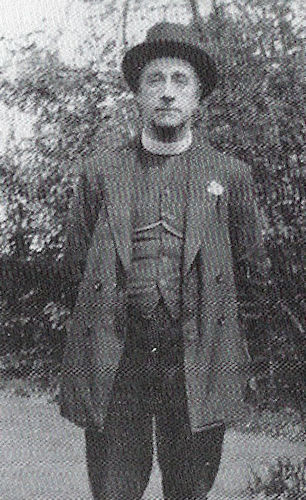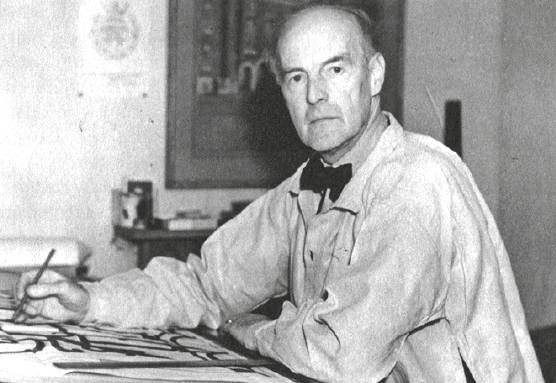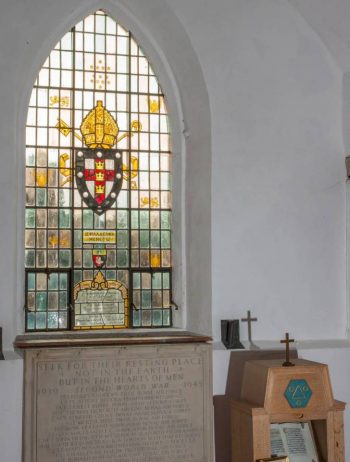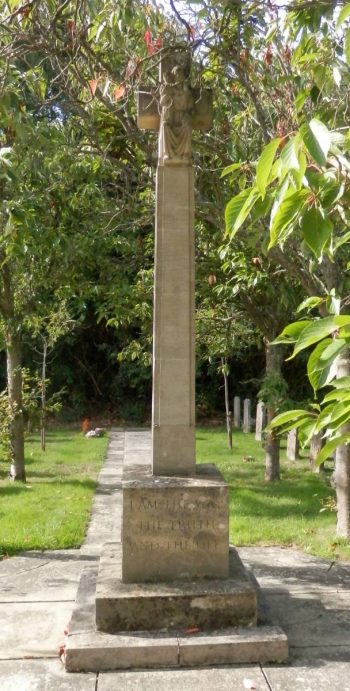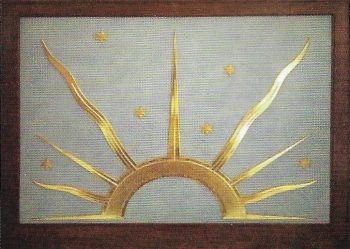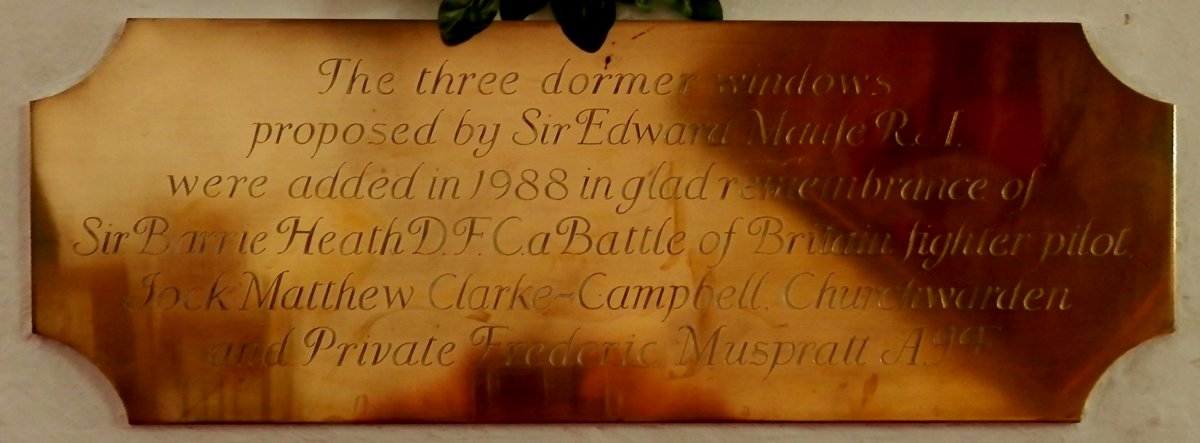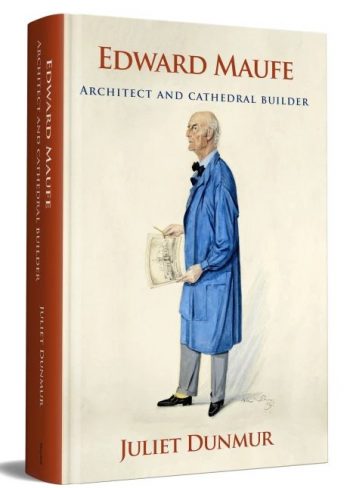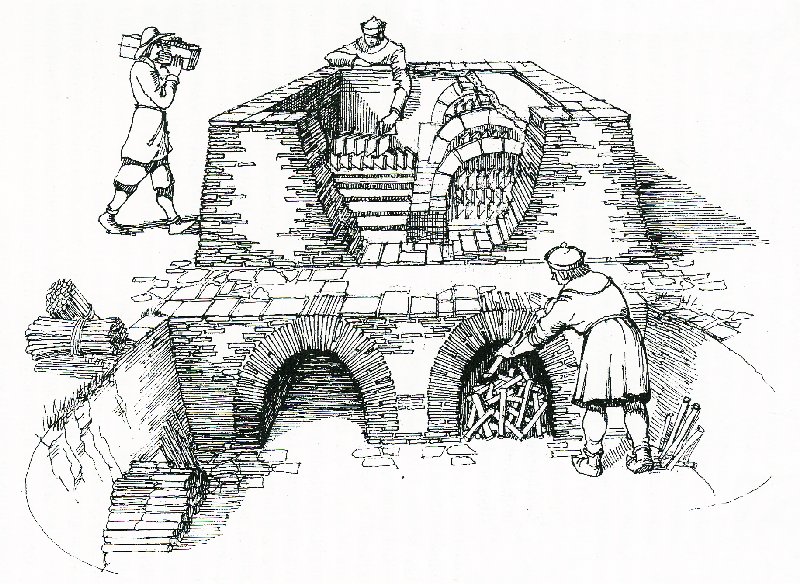Introduction
Holy Trinity, Penn is a lovely old church. People often ask how old it is and, of course, the answer depends on which part you are looking at. Every generation for over 800 years has left its mark, for better or for worse, and the church has grown and been significantly changed over the centuries. It is a remarkable testament to our many predecessors, a visible history of the parish, marking the passing fortunes, fashions and beliefs of successive generations.
When a local lord founded a church he would generally have paid for its building and provided the land both for the church and its priest. It was therefore regarded as his property. He was the proprietor and could dispose of the church as he wished. He could appoint the priest and expect an income from church dues paid by parishioners. However, it eventually became an established custom that the proprietor owned and paid for the upkeep only of the chancel, whilst the parishioners were responsible for the nave, the main body of the church.
Piety and community pride often resulted in medieval parishioners expending very large sums on their church and its furnishings. After the Reformation this was no longer the case and, for a century and a half, Puritan contempt for outward forms and sacraments led to the destruction of much that was valuable and to shocking neglect of churches. Thereafter, major changes usually depended on the wealth and willingness of the proprietor. Penn has been fortunate in achieving a balance which has usually avoided neglect and limited re-building.
The church has followed a typical pattern of development, starting as a simple, low, barn-like building with a small, probably rounded sanctuary at the east end, poorly lit by only a few narrow single lancet windows, with a rush strewn uneven earth floor and no seats. Over the centuries it has expanded in almost every direction as the population grew and building techniques improved, allowing larger windows and taller, thinner walls supported by buttresses. The roof has been raised twice, by a total of nine feet, and the windows have been increased in number and altered in practically every century. For instance, there have been at least four different east windows since the Reformation and furniture and decoration has been altered as frequently.. All these changes, and where possible an explanation for them, are set out below, as far as possible in chronological order.
The siting of the church and churchyard
Evidence for the location of an earlier church at Church Knoll, almost certainly wooden and without a graveyard, is very strong, but our concern here is with our present church. According to the date on a foundation stone under the end of the chancel, reported by a reliable earlier vicar, the chancel was built in 1177. It was sited precisely on the highest spot of ground closest to the manor house, now Penbury Farm, to which it was linked by a track, still a footpath, that comes out between the cottages on Pauls Hill and heads for the south porch door.
Whereas Saxon churchyards were usually roughly circular, the Normans introduced a rectangular form, usually of one customary acre, which is what we have after removing a 1904 addition on the western boundary. The church’s position was decided by the highest ground, but it is also set very precisely in the middle of the N-S axis of the churchyard. This seems more likely to have been deliberate than fortuitous, and suggests that the churchyard was drawn around the church, after the church was built.
The drawing of the churchyard boundary to put the church at its western edge, may well also have been deliberate, to permit more space for burials around the chancel, the holiest part of the church. The normal prejudice against the north as the devil’s side, did not seem to have been very strong, because although there have been visibly more burials to the south, the favoured sunny side where every medieval church had a tall churchyard cross, two important graves lined with 14th century Penn tiles were found immediately outside the north porch door in 1967. The north was also the village side, which would have made it less threatening.
Orientation
Ecclesiastical law and custom required a church to face to the east, the direction from which Christ, symbolised by the rising sun, is supposed to come on Judgement Day, but as our sunrise moves through 80º between midwinter and midsummer, at about 3º every week, so it depends what date is chosen. In addition, there are the practical difficulties of whether there is any view of the horizon from the site of the church that is not obscured by trees or hillside and indeed, whether the sun is shining at all at dawn.
The orientation of different churches varies over a spread of some 75º around true east (Lichfield cathedral is 40º W and Rochester cathedral at 35º E). Several ingenious explanations have been proposed to explain this lack of any uniformity; that it was the choice of sunrise on the day of the saint to whom the church was first dedicated (but note that feasts like Holy Trinity are moveable because they depend on Easter and the full moon); that it was sunrise on the day of important church festivals; that a magnetic compass was used, which introduces the very variable factor of magnetic variation over time. One or other of these explanations will often fit a particular church, but Penn’s orientation seems to be explained more straightforwardly.
Durandus, a 13th century French bishop and leading canon lawyer, reported an early tradition of using sunrise at the spring or autumn equinoxes, i.e. true east?? This works for Penn church which, from a large-scale map, is set at 4º north of true east, but, in 1177, after allowing for the inaccuracy of the Julian calendar, was originally set out at less than 1º north of true east at the vernal equinox. (fn The Julian calendar, established in 45BC, ran increasingly behind solar time until, in 1752, a once-only 11 days was added to bring it up to date. Calendar time was lagging solar time by 0.61 days every century, which, by 1177, was equivalent to 7 day. Thus when the church was laid out on what was then 21March 1177, sunrise was a week ahead of the equinox, i.e. about 3.3º north of east.
The medieval nave and south aisle and the later chancel are all in alignment (an accurate check was made measuring off a central laser line set parallel with the north wall of the nave and with a chalk line outside), but the outer walls of the Lady Chapel (and the walls of the chancel arch) are not. They are 3º to 4º out of line. This tells us that the Lady Chapel was not built at the same time as the nave or the south aisle. Typically, the 13th century saw a rounded sanctuary enlarged to a square-ended chancel with the addition of a chapel in the SE corner. Presumably our Lady Chapel was aligned to this earlier chancel, which was unlikely to have been built out of alignment with the nave as a result of careless workmanship nor, as the more fanciful would have it, to create a ‘weeping chancel’ as a symbol of Christ’s head on the cross inclined northwards towards the penitent thief. It is quite common to find a nave and chancel on different alignments and this appears to have been a deliberate attempt to correct the ‘mistaken’ direction of earlier builders.
12thCentury The Norman church
The reported date of 1177 on a foundation stone under the chancel ties in with the earliest mention of a priest, ‘Hugh, Clerk of Penn’, in 1183. The oldest part of the building is the flint nave (the main body of the church), which is the surviving heart of the original, smaller and simpler church. Three of the original twelve consecration crosses have survived in the nave, and the font and stone coffin (popularly known as the Crusader’s tomb), also belong to the same period. None of the original windows, which would typically have been very narrow lancets at say 4 ft intervals, perhaps with wooden shutters rather than glass, have survived. The only surviving lancet window in the nave, rediscovered when rendering was removed in 1952, is late 13th century. The remains of a double lancet window of the same date?? can be seen next to it. The double lancet was replaced by the Victorians with a matching copy of the late 15th century window on the other side of the porch.
The name of Pauls Hill, the lane leading up to the church from Forty Green, was Old Pauls Lane on the 1855 Inclosure map and a nearby farm was called Old Pauls. This raises the possibility that the original dedication of the church was to St Paul before it was rededicated to Holy Trinity. This often happened after a major change to the church. The earliest written reference to Holy Trinity so far discovered is in a will of 1505.
13th to 15thCentury The medieval church
We have seen that a rounded sanctuary probably gave way to a square-ended chancel in the 13th century with the Lady Chapel probably added at the same time. The very visible marks of a cross-gable above the centre arch of the south nave wall and of the line of its side walls, show that there was an earlier south porch attached directly to the nave, which, judging from its height, could have had a small room above it. The present north porch is now the main entrance, but its oak outer door is 15th century and this earlier south porch seems to have been the earlier main entrance. There is supporting evidence for this – The track from the manor house at Penbury came to the south side of the church[1]; the font was by the south door, until 1952; and two Penn graves, lined with mid-14th century Penn floor tiles, were found immediately outside the north porch door and would have blocked its entrance.
The flint tower, judging by its west lancet window and by its lancet arch to the nave, was added in c.1325, using the existing west wall of the nave as one of its walls. The buttresses are probably original – one is underneath a nave buttress – but have been repaired and embellished at various times (fn In 1637, the visitation report reported….and repairs…) It had four bells as well as the sanctus bell by 1552. The grooves made by pulling the sanctus bell rope can still be seen at the top of the lancet arch between the tower and the nave. The ringer stood in the nave so that he could see when the priest in the chancel had raised the Host up in the air and rang his bell to alert the congregation to look and so be blessed.[2] The south aisle, judging by the trefoiled ogee lights of the one surviving original window, was added in c.1350, presumably on each side of the pre-existing south porch with an archway through both its side walls to allow a continuous aisle. The three nave side arches were then broken through from the nave to the new aisle.
The addition of the tower and south aisle coincided with the transfer of ownership of the church to Chacombe Priory in Northamptonshire and this may have been when the dedication of the church was changed from St Paul to Holy Trinity. As proprietor, the Priory was directly responsible only for the chancel, and religious houses were anyway typically reluctant to spend money on their churches, which were prized as a source of income. The parishioners probably met the cost since the 14th century was a time of prosperity for the parishioners because, at that time, Penn had the most extensive and successful commercial tileries in Britain. Penn floor and roof tiles were being sold in vast quantities for most of the major buildings in London and the South East, including Westminster Palace, the Tower of London and Windsor Castle. Examples of these Penn tiles are set in the floor of the Lady Chapel. Roof tiles were used to decorate and bond the walls and buttresses of the church. A pine chest in the south aisle survives from this period.[3]
In the early 1400s, the walls of the nave were raised five or six feet, supported by new buttresses on the north side, and the present very fine queenpost roof was built. The roof is supported by stone corbels, some carved with figures and others with coats of arms, all of which are relevant to the history of the parish.[4] Three clerestorey windows were added to the newly heightened section of the walls along both sides of the nave and the two nearest to the chancel were placed as close as possible to the Rood and Doom to provide more light for them. The top of the gable of the old south porch must have been lowered below the new central clerestorey window. It was at this stage that the now well-known painting of the Doom or Last Judgement was put up as a tympanum, on oak boards, 12 feet wide and 7 feet high, fitting across the open top of the chancel arch beneath the tie beam. Only five such examples survive in England and Penn’s is incomparably the richest in colour.
The nave was then dominated by the Rood, the figure of the crucified Christ, flanked by Mary and John, hanging below the Doom in front of the chancel arch and resting on the Rood loft, a gallery above the Rood screen, to which access was gained from the south aisle via a ladder or staircase through a lower Rood loft entrance only re-discovered in 2004. The carved wooden Rood screen below the Rood loft marked the division between the people’s nave and the priestly mysteries of the chancel and was the usual place for hearing confession. Both loft and screen would have been elaborately carved, coloured and gilded, with painted panels on the screen of saints or apostles. The chancel had no ceiling, but, like the nave, was open to the roof timbers.[5]
In c.1480, a higher and grander Rood loft was built, probably to accommodate a parish choir and musicians as plain song and unison, involving only priest and clerk, evolved during the 15th century into part singing and unison, needing more voices. They were ideally placed on the loft to lead the singing since they could see and hear both priest and congregation.(Vallance) The loft was reached by a spiral staircase from the south aisle to the higher Rood loft entrance, rediscovered in 1952, still to be seen on the south wall of the nave. Because the Rood was now higher up, the Doom also had to be raised and so was repainted in a simpler style with brilliant colours to compensate both for its higher position and to take account of the blackening of lead pigments, particularly the gold paint of the haloes, and the unavoidable overlap by the top of the Rood. Widespread evidence of wall-painting was found when steam cleaning the nave walls in 1952. The red band behind the pulpit is part of a very typical medieval decorative dado pattern representing a skirting along the lower part of the wall. There is also a typical six-petalled flower. Holy drawings, of Christ or the Saints or the consecration crosses, were protected by being put higher up, out of easy reach. There is documentary evidence of at least eight separate altars and images throughout the church, which had candles burning in front of hem.[6]
16th & 17thCentury The Tudor & Stuart church
Chacombe Priory appointed the Vicar for the two centuries before the Reformation, but when Henry VIII finally broke from Rome, in 1534, and declared himself head of the Anglican Church, the Priory was dissolved the following year and the Prior pensioned off. In October 1538, Sybil Penne, wife of David Penne, the lord of the manor of Penn, was appointed nurse and foster-mother to the sickly, year-old future Edward VI. It was a position of the greatest importance and one of her rewards from a grateful Henry VIII, in 1541, was the proprietorship and advowson (the right to appoint the vicar) of Penn Church.[7]
Meanwhile the Protestant advance continued, eroding all the familiar religious customs. In 1539, the Vicar of Penn was put in Aylesbury gaol by his own churchwardens for ‘uttering certain opprobrious words’, but the final break with Catholicism came after Henry’s death in 1547, which unleashed a tide of unrestricted Puritan reform. Everywhere, the Rood and Rood loft were removed, stained glass was smashed, the Doom and all the wall-paintings were whitewashed, and all images and altars were removed. The stone high altar with its candlesticks and decoration was replaced by a simple low wooden communion table to be set in the body of the church, with communion to be a shared meal around the table like the Last Supper, celebrated by a priest wearing a simple surplice and no vestments. Mary’s brief reign from 1553 to 1558 restored Catholic practice, but this was reversed by Elizabeth. It was unarguably, the most traumatic 25 years in the life of the church.
.Some very fine Tudor and Stuart brasses, two of them including children, which were originally in the chancel and the Lady Chapel, have twice been moved and, since 1953, have been grouped on the floor of the south aisle near the Lady Chapel. They are all of the Penne family except for the earliest, to Elizabeth Rok, who seems likely to have been the first lay patron after Chacombe Priory’s dissolution. The inscription takes the unusual form of a prayer. It is dated 9 August 1540, and the beautiful prayer of the inscription is in English rather than Latin, breathing the poetry and spirit of the new Book of Common Prayer which was introduced nine years later.[8]
The consequence of the trauma of the twenty five years of Reformation and the Puritan horror of any outward show of …was a widespread indifference and neglect of church buildings. Penn is entirely typical and a century later, in1637, the church was reported to be in a terrible state of neglect with broken windows and floor, a leaking roof and the buttresses and tower in decay. At the front, there were covered private pews for the gentry families, 7 ½ foot high, blocking both the central aisle of the nave and the chancel itself. The poor sat at the back, with the others, carefully graded, in between. The report also required that ‘the church…to be new sentenced’, and fragments of four visible layers of wall painting uncovered behind the pulpit in 1952, include a Stuart wall text in the form of a long orange vertical decoration with black letter script.[9] .During the Civil War and the Commonwealth, further damage was done to many churches. A 17th century drawing of the outside of the church shows an immediately recognisable, but still significantly different church with many broken roof tiles
There are several Tudor and Stuart oak chairs – A Tudor oak box chair, known as the Bishop’s chair is in the chancel, and next to it is a Stuart oak chair with a fine incised carved seat. There is also a pair of Stuart chairs at the back of the nave. Our oldest communion cup, marked 1617, also survives from this period.
18th Century & the Georgian restoration
John Bennet, former teacher of Roger Penn and his Curzon cousins at Berkhamsted School, became Vicar in 1700, and his arrival marked the start of a period of renewal for the church. He put in 5 new bells in 1702, three of which still survive, together with the contemporary bellringers poem on the wall of the ringing chamber. A small gallery was put up over the south door, in 1703, at the expense of ‘the young men that had learned to sing psalms’. It was obligatory to display post-Reformation Anglican allegiance to the Crown rather than the Pope in the form of the royal coat of arms, and we still have a fine example of Queen Anne’s arms, painted on canvas, put up in 1709.[10] In the same year, according to the Parish register, ‘the Sentences in the Church were writt & new painted’. Part of the Lord’s Prayer, ‘Trespass against’, has been revealed painted on the wall behind the pulpit. The one-handed clock, which we still have on the tower, was put up 2 months after Bennet’s death in 1715, perhaps in memory of him. Bennet’s portrait, the earliest known of one of our Vicars, is in Penn House and the silver salver, which he gave in 1712, is still in use as an alms dish.
Roger Penn’s black marble memorial slab, in the centre of the chancel floor, marks the grave of the last male heir of the Penn family, who died in 1731. He was succeeded by his sister Sarah’s son, Sir Nathaniel Curzon of Kedleston. The house next to the church, known as The Knoll, had been built for Sarah and her husband in the 1670s. Sir Nathaniel immediately set about ‘modernising’ the church.
In 1733, the nave roof was raised again, by another three feet, and extended out over the south aisle, probably to achieve more height in the south aisle because he then widened both the eastern arch of the nave, and the chancel arch to the south, replacing the medieval lancet with the present round-headed chancel arch. All this was so that he could move three towering gentry pews that were blocking the chancel into the south aisle. We know what the chancel looked like when this reorganisation was completed because we have Henry Ziegler’s watercolours of c.1850 (of which there are photographs on the cross aisle pillars in the nave). He was drawing master to Queen Adelaide and drew very accurately. This was a period when the sermon was all-important. A good view of the preacher was essential and because high box pews were the fashion for gentry families, the preacher had to be placed on the highest level of a three-decker pulpit in order to be visible. The Bible was read from the middle level and the Clerk led the responses for a largely illiterate congregation from the bottom level.
The gabled roof of the medieval porch at the centre of the south aisle must have remained because there was still enough head room to retain the singers’ gallery above the south door. The present south porch and vestry were added. In October 1733, the congregation paid for a second gallery over the west door to the tower to cater for an increasing population.
The blocking of the three clerestorey windows on the south side would have left the nave in need of more light, particularly near the new public gallery. An 18th century print shows a three light window on the NW clerestorey right by the gallery and an 1819 drawing confirms three round-headed windows, probably of brick, which presumably replaced the original two light 15th century window of which the displaced white clunch stones are still to be seen in the wall. Two other brick windows were revealed in this same part of the north wall when the rendering was removed in 1952. The lower window appears on the 1819 drawing and was probably added in 1733, but the upper one was not then in use and Clive Rouse assumed it was Tudor because of the brick.
The fine medieval tie beams and arch braces of the roof, resting on their stone corbels were left in place and the heightened roof of the nave allowed the whitewashed Doom, by losing only a few inches of its periphery, to fit in its present position in the roof space above the tie beam over the chancel arch.
According to Sir George Grove, writing in 1886, the chancel was burned down and rebuilt.[11] There is no other record of the fire, but it does explain the very radical alterations made to the chancel by Sir Nathaniel Curzon, presumably in 1736, since this is the date above his private side door to the chancel. and.
The medieval chancel was completely rebuilt, properly aligned with the nave this time, extended by about seven feet and widened to the south by three feet. Hence, outside, the ridge of the chancel roof is offset from the nave ridge by about 1½ feet and, inside, the chancel arch is now visibly off-centre from the nave roof above.[12] A new, ‘painted’ east window, showing Christ with two disciples at Emmaus, was put in. The new chancel became a focus for family memorials and the very fine 18th and 19th century Curzon and Howe family monuments, nearly all carved from white marble, still fill the chancel walls. The Lady Chapel was then taken down to window sill level and rebuilt in brick on the medieval base. There were probably lancet arches between the Lady Chapel and the chancel and the south aisle which were removed at this stage.
William Penn, the Quaker, who founded Pennsylvania, had close connections with Penn parish. His first wife was living at Tyler End Green in Penn for two years before they were married in 1672, and both he and the manorial Penn family assumed that they were related. There is no better evidence of this than their shared coat of arms and the vault under the nave that was dug, in 1753, to take the coffins, eventually six, of William Penn the Quaker’s grandsons. It was at the third attempt to find the entrance to this vault that the two Penn tile-lined graves were discovered, just outside the north porch, in 1967.
The Baker family, who lived in Penn for a century from the 1660s, are commemorated by two elaborate marble wall monuments with Latin inscriptions, one at each end of the north wall of the nave. Daniel Baker the younger, like his father, was a wealthy London merchant who owned a ‘mansion house’ overlooking Widmer Pond.[13] His wife, Martha, despite having had 9 sons and 8 daughters in 20 years, still lived to the age of 84, dying in 1753. He gave a silver flagon and silver alms dish to the church in 1714, which are still in use, and was High Sheriff in 1721/22. His sister married Sir John Verney, Viscount Fermanagh, of Claydon, in 1696. The second monument was put up by his only surviving grandson, John Baker Holroyd, later the Earl of Sheffield, of Sheffield Place, Sussex, the year after he sold the mansion house in 1769.
Dr Roger Mather, Vicar from 1757 to 1768, is commemorated by a fine mural tablet in the Lady Chapel which records that ‘Assheton Curzon Esq was his Pupil, Patron and Friend. Mather was academic of distinction, the public orator to Oxford University for eleven years.
A mural tablet and a floor monument near the vestry door commemorates General William Haviland, a successful general who fought Bonnie Prince Charlie in 1745 and was with Wolfe in the decisive capture of Montreal. He invented the idea, still in use, of using pontoons to cross rivers. He was a friend of Edmund Burke, who wrote the epitaph recorded on the tablet.[14] His hatchment[15], showing a winged skull, is nearby in the south aisle.
Sir Nathaniel Curzon’s second son, Assheton Curzon, later Viscount Curzon, was given Penn manor on marriage in 1756, and he held the proprietorship of the church for over sixty years. His eldest son married the daughter and heiress to Admiral Richard Howe, who had been appointed commander-in-chief in North America in 1776 and received a commission, jointly with his younger brother, General Sir William Howe, who was already there in command of the army. They were ‘to treat with the revolted Americans, and to take measures for the restoration of peace with the colonies’. Admiral Howe had often talked to Benjamin Franklin about the colonists’ grievances, and was sent as a conciliator, but arrived after the declaration of independence on 4 July 1776. He was too late.
In 1797, Assheton Curzon’s eldest son died and a vault was dug for him under the east end of the extended chancel. There is a fine wall monument to him in the chancel by Bacon?? It was in this vault that the Vicar saw the date 1177 on a foundation stone. The single-light pointed window in the chancel and the one directly opposite in the Lady Chapel belong to this period. Assheton, Viscount Curzon died in 1820 aged 91, and there is a particularly fine marble wall-tablet to him in the chancel, by Sir Francis Chantrey. His hatchment hangs on the south wall of the south aisle. His father was born in Penn in 1676, so the two generations spanned nearly 150 years.
19thCentury The Howes and the Victorian restoration
The Howe earldom was revived, in 1821, for the Admiral Howe’s Curzon grandson. He was Lord Chamberlain to Queen Adelaide and his wife was her Lady of the Bedchamber. The Queen and King William visited Penn at least twice, once in 1833 and again in 1835 when they came to Penn Church as god parents to the Howe’s daughter, their tenth child. It is possible that our present box pews were put in at this time, a popular move because they reduced the draughts in a poorly heated church, as well as the wooden floor, which was laid some 18 inches above the original ground level. The pews and floor were already in place when Ziegler drew the church.
Sir George Grove’s father had had played the hautboy in Penn church as a youth in the 1780s and 90s[16], but the churchwardens’ accounts show that an organ had already been installed at the west end of the nave by 1859. It was worked by bellows and an annual payment was made for ‘organ blowing’ …
Baroness Howe was the daughter of Admiral Howe and mother of the first Earl Howe. She died in 1835 and is remembered by another Chantrey monument on the chancel walls. A third Chantrey monument is to Harriet Georgiana, Countess Howe, the first Earl Howe’s wife, who died in 1836. The present Church Hall, originally a girls’ school, was built in 1839 in her memory. This date and her initials, HGH, can be seen on the gable of the hall and there is a very good countess’s coronet just above the window of the present kitchen. Her hatchment hangs in the nave to the west of the central arch of the south wall of the nave, with that of her oldest son, the second Earl Howe, who died in 1876, to the east.
The Victorian ‘restoration’ of 1863, paid for by Earl Howe, saw the next major changes to the building. Inspired by the Oxford movement, churches all over the country were trying to restore the medieval arrangements of the Decorated period (c.1280-1380). Fortunately, our mainly 14th century nave and tower were seen as ‘correct’, but the two lancet windows in the north wall were presumably regarded as too early and so the single lancet was blocked in (to be rediscovered in 1952) and the double lancet was replaced by a copy of the late 15th century window on the other side of the porch. The three-light brick window in the NW clerestory was rebuilt as a copy of the other two original 15th century clerestory windows and the lower brick window was filled in. All these changes were aimed at producing a symmetrical all-Gothic appearance to the north wall.
Two semi-dormer windows in the south aisle were put in, presumably replacing either worn out original, 14th century windows or unacceptable later replacements. The 18th century public gallery was removed, together with the three–decker pulpit and the remaining high pews. The small 18th century choir gallery over the south door was no longer wanted and so the gabled roof and side walls of the medieval porch which had provided the headroom was taken down causing, judging by the ‘modern’ smoothness of the plaster, a partial collapse of the arch below the central clerestory window.
In 1865, the 18th century east wall of the chancel was rebuilt with knapped black flints and a more suitably Gothic east window installed. An altar was restored after more than three centuries with a cross and candlesticks, although the altar was of wood rather than stone. In some parts of the country during the 1840s and 1850s, preaching in a surplice or having a cross and candlesticks on altar were enough to start a riot. Penn was never so extreme aand the parish register records the wearing of a surplice as early as 1707 and the gift if a brass branch candlestick in 1749. The eagle lectern, another reversion to medieval tradition, was probably installed around this time and Victorian tiles laid on all the floors?? The natural colour of the oak of the roof timbers only survives in the tower; elsewhere they were stained black at some stage?? The very fine, early 18th century pulpit, oak with marquetry, arrived from the Curzon chapel in Mayfair when it was closed in 1899.
20th Century
The Vicar in 1802 had named ten counties that he could see clearly from the top of the tower, with perhaps two more.[17] By 1903, the tower was cracked from top to bottom and needed much work; in 1910, the parapet was rebuilt and the upper windows replaced; in 1919 it was strengthened with bricks to take a steel frame for all the retuned bells including a new, sixth ‘Peace’ bell. In 1920, a clock was placed in the belfry to the memory of ‘Old Tom Fryer’ who had rung the bells for 67 years. In 1993 the lead roof was replaced.
The church school, by now both boys and girls, was considerably extended in 1910. The lych gate was built at a cost of £100, in 1913, to commemorate what was erroneously thought to be the church’s 700th anniversary. In 1918, Earl Howe replaced the last of the medieval Penn tiles on the chancel floor with marble tiles. The fallen in the two World Wars are commemorated by a war memorial outside the church put up in 1922 and inside by a Remembrance Book, a memorial tablet in the Lady Chapel and by most of the stained glass windows. In 1924, the removal of plaster from the interior of the roof revealed the splendid arcading. In 1931, the High Church Vicar wanted posts and curtains around the altar in the Catholic medieval fashion, and since this obscured the lower part of the Victorian east window, the present, truncated east window, was commissioned. The curtains were removed in 2003. Earl Howe’s 17th century family pew, which had returned to the chancel in 1916, against some protest, was moved to the front of the nave in 1947.
In 1938, electric light was installed and, in the same year, the medieval Doom painting, concealed under lath and plaster and whitewash, was levered out of the roof in pieces and tossed into the graveyard where its significance was only discovered by accident after rain revealed a painted face. In 1951, the rendering was taken off the outside walls to reveal the beguiling patterns of brick, flint and clunch that we enjoy today. In 1966, the present specially-designed organ was installed. The plate glass screen and doors, which purport to illustrate the manorial Penn family connections with William Penn the Quaker, were put up in the north porch in 1986. Light to the nave via the three clerestorey windows on the south wall of the nave was restored by the three dormer windows in the roof, added in 1988. The Lady Chapel was completely re-ordered, as a millennium project, with a specially commissioned painting, new furniture and a Penn tile floor.
Miles Green, April 2005
Footnotes
[1] The present main road between the Crown and Penbury Farm was only put in c.1840, perhaps to enable easier access to the new girls’ school, built in 1839 (now the Church Hall). The way to Knotty Green and Beaconsfield used to be down Crown Lane and up to Penbury.
[2] This was the most important moment in the service and was later used as a test of Lollardy.
[3] A ‘Deal Strong Box with a lock & key’ was given by Dr Roger Mather, the Vicar in 1763 to keep the embroidered new ‘Cloth of the Communion table’ and prayer books that he had just provided.
[4] In 1952, an expert investigation of the corbels revealed….
[5] The 1637 Visitation report noted that the chancel needed to be ‘ceiled throughout’
[6] Early 16th century wills reveal ….
[7] The present Earl Howe is her descendant and still lives in the parish and owns these rights
[8] This one of the earliest examples of an ecclesiastical inscription in English following royal injunctions of 1536 & 1538 requiring clergy to teach the Lord’s Prayer, Creed and 10 Commandments in English, not Latin, and to put a bible in English in the church for anyone to read
[9] Many more layers will be hidden because, according to Clive Rouse, a well-cared for church was redecorated every 25 years or so
[10] These are the Stuart Arms that were in force from James 1 in 1603. The Royal Arms were changed in 1707 after the union with Scotland, but the change is not reflected here, even though the parish register records that they were hung in 1709
[11] Sir George Grove (1820-1900) was the grandson of Edmund Grove (1729-1823) and though he gives no source for his story of a fire, it was presumably a family memory that he recorded in his article, ‘A country church’ in the St James Gazette for 27 Sep 1886
[12] The placing on the chancel floor of the monuments to three sisters of Roger Penn, who were buried between 17?? and 17 ?? , is a strong indication that the medieval chancel had not yet been widened. It would anyway have been very unusual for a medieval chancel to be widened on one side only since this would have put the chancel out of action for months which was not then acceptable. The normal practice was to build the new chancel around the old and so reduce the disruption to a minimum.
[13] He was a deeply religious man and kept a diary from 1690-1705 (a booklet has been published locally) to remind him of the awful mishaps in which he narrowly escaped disaster but for the Grace of God. He fell out badly with the Vicar, Benjamin Robertshaw. The house was later used for the school for French émigré boys that was established by Edmund Burke in 1797.
[14] A photograph of 19?? And an architect’s plan of 19?? Show that Haviland’s ….were originally….
[15] Hatchments (the word is corrupted from ‘achievements’) were the arms of a deceased person, set on canvas or wooden panels within a black lozenge-shaped frame, meant to be displayed on the front of his house for the period of mourning, before being moved inside the church. They were particularly popular in the late 18th & early 19th centuries.
[16] A hautboy was an older form of oboe, often played with violin and bassoon
[17] ‘Bucks of course, Berks, Hants, Oxford, Bedford, Herts, Essex, Kent, Middlesex and Surrey; perhaps also Northampton and Sussex’.

